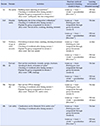Abstract
Purpose
This study was performed to determine effects of a structure-centered cooperative learning safety education program based on blended learning for elementary school students.
Methods
The study is developed in non-equivalent control group non-synchronized design. The subjects included 24 sixth grade students in the experimental group and 23 sixth grade students in the control group, respectively. To prevent diffusion of the experiment, it was carried out from May 20th to June 24th in 2015 with the control group and the other from August 26th to September 30th in 2015 with the experimental group. It was performed on experimental group after the structure-centered cooperative learning safety education program based on blended learning once a week for 6weeks. Data were analyzed by using descriptive statistics, paired t-test and independent t-test.
Figures and Tables
Table 1
Structure-centered Cooperative Learning Safety Education Program based on Blended Learning

CPR=cardiopulmonary resuscitation; †Structure-centered cooperative learning of Kagan (2010); ‡Structure : 1) Using of the ⌜structure-selectionchart⌟ for selection, 2) Application of various structures for each phase, 3) Using in the classroom; §Blended learning: off-line (classroom) + on-line (cafe site).
References
1. Lee MS. The actual conditions and tasks of safety education of schools. Seoul Education. 2008; 50(2):52–56.
2. Lee HS. The practical suggestion for the production of educational animation for prevention of safety accidents. Journal of the Korea Contents Association. 2018; 18(6):169–179.
3. Hall-Long BA, Schell K, Corrigan V. Youth safety education and injury prevention program. Pediatric Nursing. 2001; 27(2):141–146.

4. Jung HM, Lee HC. Development and effect of elementary school upper-grade safety health education program. Korean Journal of Emergency Medical Services. 2013; 17(3):149–168.

5. Statistics Korea. Child Death Due to Accident: 1996–2016 [Internet]. Seoul: Statistics Korea;2018. cited 2018 september 19. Available from: http://www.korea.kr/briefing/pressReleaseView.do?newsId=156267855&pageIndex=1&repCodeType=&repCode=&startDate=2008-02-29&2018-09-19&srchWord.
6. Department of Consumer Injury Information. Analysis of child safety accident trends. Safety Research Report. Eumseong: Korea Consumer Agency;2017. 06. Report No.: 2017-6.
7. Kang JC. The development of study skills training program on blended learning environment for advancing the self-directed learning ability. Journal of Elementary Education. 2010; 23(3):239–265.
8. Gibbons M. The self-directed learning handbook: challenging adolescent students to excel. 1st ed. San Francisco: Jossey-Bass;2002. p. 208.
9. Lee JH. Analysis of the structural relationships among self-determination motivation to learn, metacognition, self-directed learning ability, learning flow, and school achievement. Korean Journal of Educational Research. 2010; 48(2):67–92.
10. Lim YT, Lee MH, Park YS, Kwon SM. Implementation of blended learning in PE Class: Focusing on the exploration of the middle school students' experiential meaning. Korean Journal of Sport Science. 2009; 20(4):885–899.
11. Kwon SH, Yoo JT, Lee J, Seo YG. A study and investigation on the current situation of cyber education. Research Report. Seoul: Korea Education and Research Information Service;2001. 12. Report No.: RR 2001-6.
12. Moon ST, Bak MH. The study on relationship between learning self-efficacy and career preparation among university students: The mediating role of optimism. The Journal of Career Education Research. 2013; 26(3):185–204.
13. Ku BD. A Meta-analysis on the effects of academic achievement in cooperative learning. Journal of Agricultural Education and Human Resource Development. 2013; 45(3):39–61. DOI: 10.23840/agehrd.2013.45.3.39.
14. Kim EJ. A study on the cooperative learning approach in child safety education. The Research of Child Education and Care. 2006; 2(2):5–26.
15. Shin HJ, Lee GH, Lee JS, Lee JS, Kim DN, Han MS, et al. Cooperative learning method of korean language department. 1st ed. Seoul: Pagijong;2003. p. 280.
16. Kagan S. Cooperative learning. 13th ed. Suwon: Timothy;2010. p. 557.
17. Jung GO, Yang HJ, Choi SY. A design and implementation of web-based cooperative learning system on structural approach. Journal of Korean Association of Computer Education. 2004; 7(3):111–121.
18. Yang JY, Kim SS, Kim HY. The roles as a teacher on school safety. Korean Journal of Sports Science. 2018; 27(1):651–658.

19. Chung ES, Jung IS, Song MG. Development and effect analysis of web-based instruction program to prevent elementary school students from safety accidents. Journal of Korean Academy of Nursing. 2004; 34(3):485–495.


20. Kwon SS. Development and effect evaluation of safety education program for higher grade students of elementary school. Journal of the Korean Society of School Health. 2005; 18(2):45–61.
21. Kim HJ. The effect and development of FLSE teaching model using web contents for efficient elementary safety education [master's thesis]. [lncheon]: Gyeongin National University of Education;2015. 69.
22. Kim CJ, Kim KS, Yoo KO, Yoo GH. A study on development of self-directed learning readiness scale for primary school teachers and its applications. Korean Journal of Adult & Continuing Education. 1996; 2(1):1–25.
23. Jung MK. The effects of problem-based instruction on self-directed learning attitudes of elementary school children [master's thesis]. [Chungbuk]: Korea National University of Education;2002. 74.
24. Kim AY, Park IY. Construction and validation of academic self-efficacy scale. Journal of Educational Research. 2001; 39(1):95–123.
25. Waltz CW, Bausell RB. Nursing research: Design, statistics and computer analysis. Philadelphia, PA: F.A. Davis Co;1981. p. 362.
26. Lee CH. Model development and application of creative engineering design education program based on ADDIE Model. The Korean Journal of Technology Education. 2008; 8(1):131–146.
27. Jeong SH. Systematic review of the literatures on music intervention for neurological patients in korea. Journal of Korean Biological Nursing Science. 2013; 15(2):65–73. DOI: 10.7586/jkbns.2013.15.2.65.

28. Ha YJ, Woo SJ, Seo NS. A convergence study on the effects of blended learning on the self-directed learning ability and learning satisfaction of nursing students. Journal of the Korea Convergence Society. 2018; 9(11):509–517.
29. Lee HJ. The effects of a blended learning model on self-directed learning in higher english education. Journal of Educational Information and Media. 2012; 18(1):1–24.
30. Choe IG, Lee AS. Effects of blended-learning on self-efficacy and attitude in elementary physical education classes. Korean Journal of Sport Pedagogy. 2010; 17(3):95–114.




 PDF
PDF ePub
ePub Citation
Citation Print
Print







 XML Download
XML Download